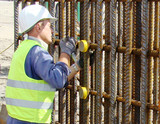Sensors protect Rotterdamer quayside
The saline seawater ceaselessly eats into the concrete of the quayside, day after day, year after year. These are the most difficult conditions that steel-reinforced concrete has to withstand. The salt, in form of salt ions, penetrates the alkaline concrete and neutralizes it, i.e. alters it chemically. The situation becomes especially dire if the ions reach the steel reinforcement. The steel rods corrode, crevices form, and slabs of concrete can fracture and separate. In a word, the quayside loses its stability. However, it is difficult to establish when the harmful ions have penetrated far enough through the concrete to attack the steel as well.
Things are different with the new quayside in Rotterdam. The construction company has integrated passive RFID sensors along the reinforcing rods during quay construction. Once the salt ions reach a sensor, they eat away its special wire. The more of them that are corroded by the ions, the more advanced the corrosion has become. A transponder in the sensor transmits the data to an RFID reader. The extent of the hazard is displayed to the harbor official responsible for the quayside. As a result, maintenance work on the structure can be initiated before the reinforcement is damaged. This makes it possible to save millions in concrete construction costs. The sensor was developed by staff at BS2 Sicherheitssystems GmbH in Boppard, Germany. Researchers of the Fraunhofer Institute for Microelectronic Circuits and Systems IMS in Duisburg integrated the passive, wireless transponder system. The scientists will be presenting the system at the EURO ID 2013 trade fair in Frankfurt, Germany, from November 5-7 (Hall 4, Booth D08).
